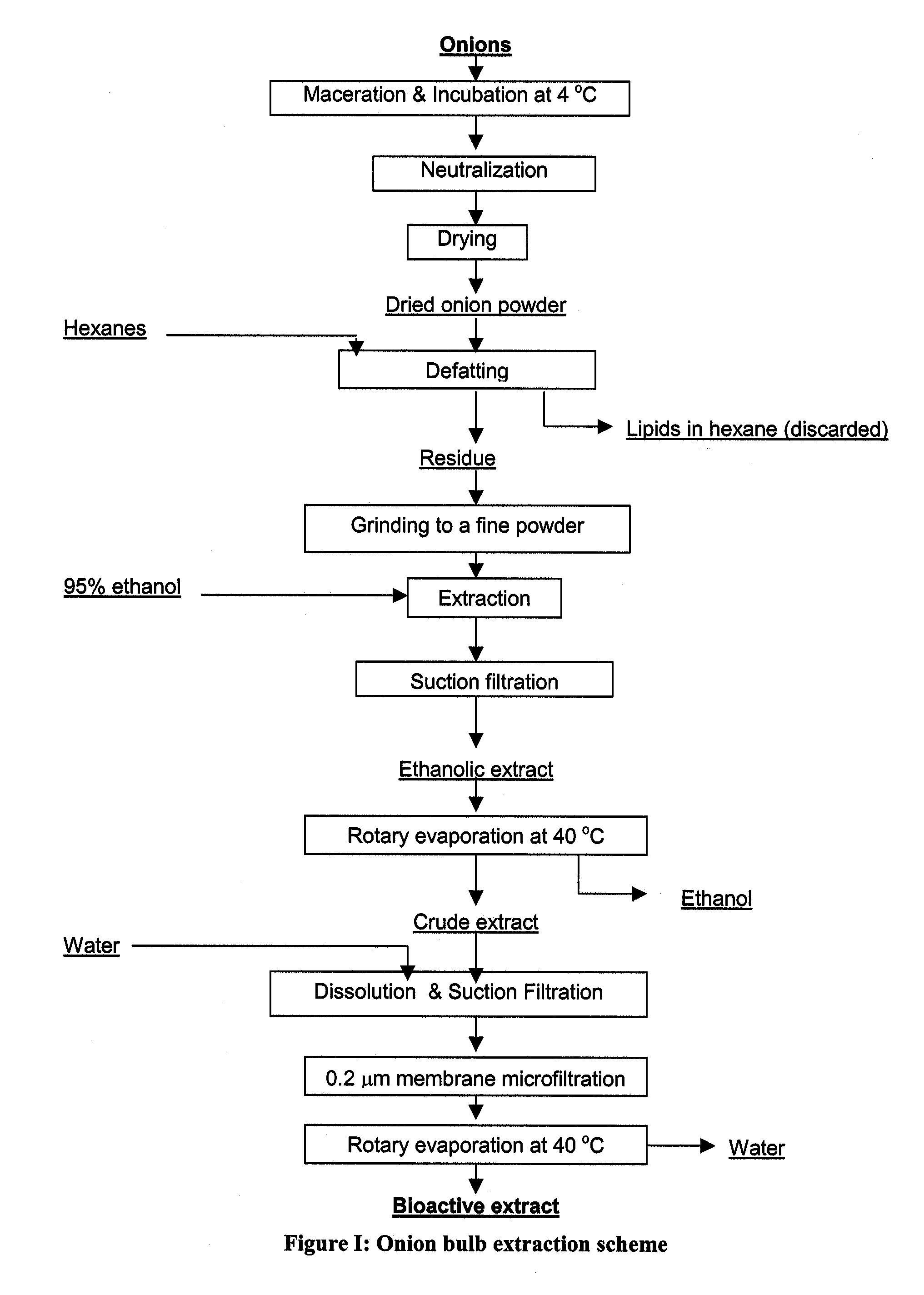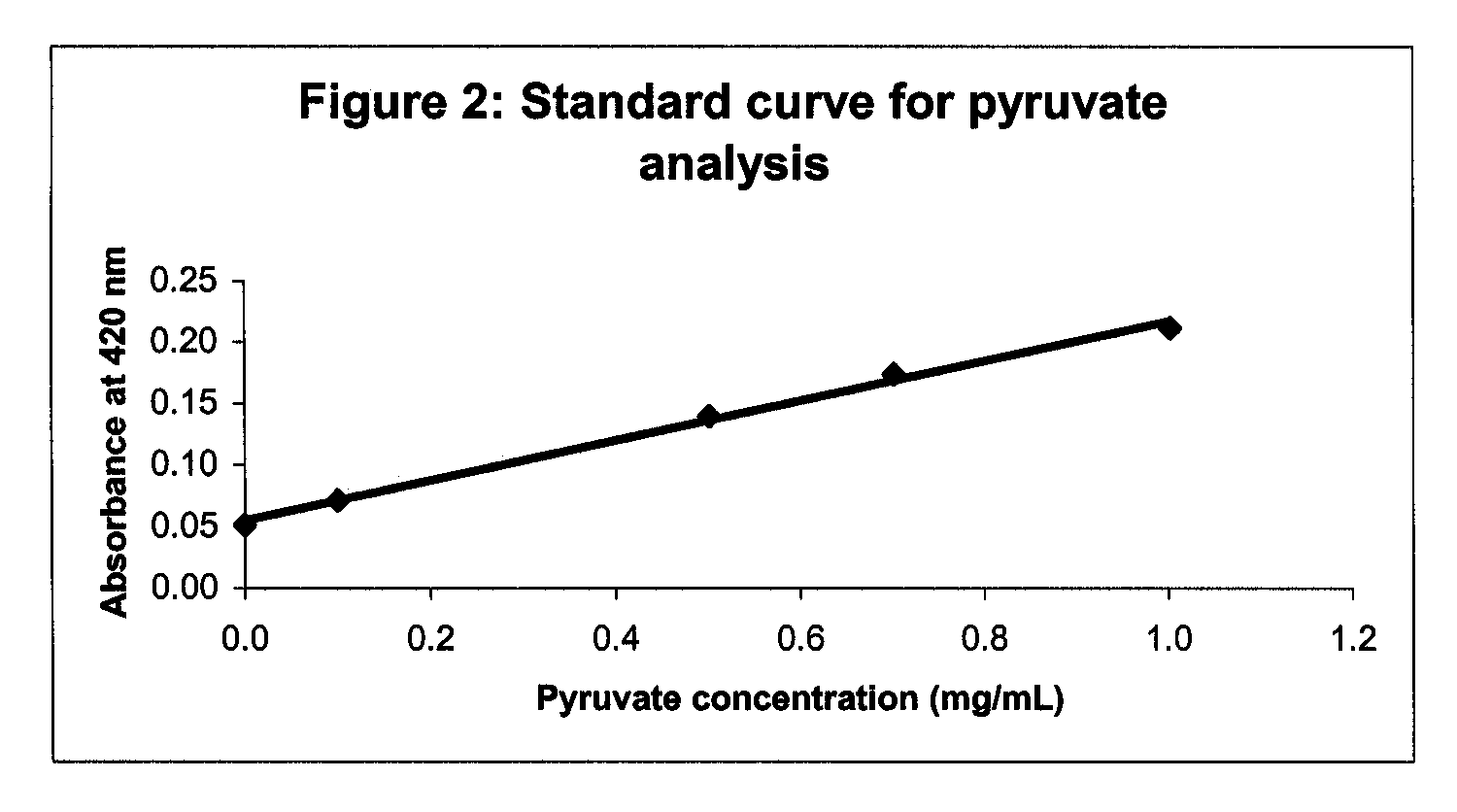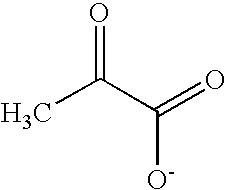Pyruvate enriched onion extract
a technology of pyruvate and onion, applied in the field of antioxidant extract, can solve the problems of oxidative stress, severe damage to the cell structure, generation of free radical species, etc., and achieve the effects of enhancing antioxidant activity, enhancing pyruvate content in plant extracts, and being more bioavailable and stabl
- Summary
- Abstract
- Description
- Claims
- Application Information
AI Technical Summary
Benefits of technology
Problems solved by technology
Method used
Image
Examples
example i
Preparation of the Extract
[0040] (a) Enhancement of Pyruvate Production In Situ
[0041] Onions (1 kg) were refrigerated overnight, peeled, cut in half and crushed in a food processor. Crushed onions were incubated in an ice bath (4° C.) and at 25° C. for different durations. Sodium hydroxide was added to neutralize the slurry, mixed well and dried at 20° C. for 48 h. Dried onion was then defatted using hexanes and any residual hexane was evaporated. Defatted onion was then ground to a fine powder and subjected to extraction with 95% (v / v) ethanol at 50 OLE_LINK1° C. for 2hOLE_LINK1. Liquid extracts were filtered under suction. The resultant ethanolic filtrate was rotary evaporated and the pyruvate concentration of the residue was determined.
[0042] Table 1 shows the pyruvate yield of residues obtained under different incubation conditions. About 2 to 3-fold enhancement in pyruvate yields could be obtained by incubation at 4° C. for 30 min.
TABLE 1Pyruvate yield as a function of inc...
example ii
Characterization of the Extract
[0048] (a) Total Pyruvate Content
[0049] Solutions were prepared by dissolving onion extracts in water. A series of aqueous standard solutions containing pyruvic acid at 0, 0.026, 0.052, 0.104, 0.207, 0.414, 0.829 and 1.66 mg / mL were used to determine the standard curve.
[0050] 0.5 mL from each solution was transferred separately into 50 mL centrifuge tubes and allowed to stand for 10 min. A 1.5 mL aliquot of aqueous trichloroacetic acid (TCA, 5%, w / v) was added into each tube, vortexed and to this, 18 mL of distilled water was further added. Tubes were vortexed and a 1 mL aliquot transferred into 10 mL screw-capped test tubes. 1 mL of 0.0125% 2,4-dinitrophenylhydrazine (prepared in 2N hydrochloric acid) was then added into each tube, along with 1 mL of distilled water and vortexed. Tubes were then heated for 10 min at 37° C. 5 mL of 0.6N sodium hydroxide was added into each tube, vortexed and the absorbance of the resulting brick-red complex was meas...
example iii
Antioxidant Activity
[0056] (a) Inhibition (%) of ABTS Radical Generation
[0057] All reagents used in this assay were prepared in phosphate buffered saline (PBS, 10 mM, pH 7.4). Sample solutions were prepared in PBS.
[0058] 100 μL of 2.5 mM ABTS (2-2′-azino-bis(3-ethylbenzathiazoline-6-sulfonic acid), 180 μL of 50 μM metmyoglobin, 790 μL PBS and 10 μL of onion extract (final assay concentration of 454 μg / mL) were mixed in a disposable cuvette. Reaction was triggered by the addition of 120 μL of 10 mM hydrogen peroxide. Absorbance data of the reaction mixture were recorded after 10 min using a spectrophotometer set at 734 nm. Quercetin was used as a reference antioxidant.
[0059] Inhibition (%) of ABTS radical generation was calculated using the following equation: % inhibition=[(Abscontrol−AbsSample) / Abscontrol]*100 Table IV shows the typical data obtained for standard quercetin and the onion extract.
TABLE 4Inhibition (%) of ABTS Radical GenerationComponent% inhibitionconcentration...
PUM
| Property | Measurement | Unit |
|---|---|---|
| temperature | aaaaa | aaaaa |
| temperature | aaaaa | aaaaa |
| concentration | aaaaa | aaaaa |
Abstract
Description
Claims
Application Information
 Login to View More
Login to View More - R&D
- Intellectual Property
- Life Sciences
- Materials
- Tech Scout
- Unparalleled Data Quality
- Higher Quality Content
- 60% Fewer Hallucinations
Browse by: Latest US Patents, China's latest patents, Technical Efficacy Thesaurus, Application Domain, Technology Topic, Popular Technical Reports.
© 2025 PatSnap. All rights reserved.Legal|Privacy policy|Modern Slavery Act Transparency Statement|Sitemap|About US| Contact US: help@patsnap.com



